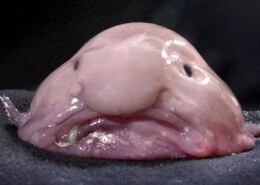In the vast, mysterious depths of the ocean lives a creature that has become the unfortunate poster child for “ugly animals” everywhere—the blobfish. With its droopy features and gelatinous form, the blobfish has been ridiculed across the internet, crowned “the world’s ugliest animal,” and turned into countless memes. But behind its strange appearance lies a misunderstood marvel of deep-sea evolution.
This is the real story of the blobfish—one of the ocean’s most unfairly judged residents.
Meet the Blobfish: Who (and What) Is It?
The blobfish (Psychrolutes marcidus) is a deep-sea fish native to the waters off the coasts of Australia, New Zealand, and Tasmania. It lives at depths between 600 and 1,200 meters (2,000 to 4,000 feet), where the pressure is over 100 times greater than at the surface.
At those depths, bones would be crushed and lungs would collapse—but not for the blobfish. Its soft, jelly-like body is uniquely adapted to survive extreme pressure. In fact, the blobfish doesn’t have a swim bladder like many fish. Instead, its low-density, gelatinous flesh allows it to hover just above the ocean floor without expending much energy.
Why Does It Look So… Sad?
The infamous image of the blobfish, with its sagging nose and miserable expression, is actually a result of human interference. That sad-faced creature is what a blobfish looks like after it’s been hauled to the surface.
In its natural environment—crushed under tons of water pressure—the blobfish looks much more like a normal fish: compact, firm, and well-proportioned. But when it’s brought to the surface, its soft tissues expand and deform because they’re no longer being compressed by the pressure of the deep ocean. It’s like taking a balloon from the deep sea to a mountaintop—it’s going to look very different.
So, the blobfish isn’t “ugly” by nature—it’s just a victim of poor PR and extreme physics.
An Accidental Icon
The blobfish shot to fame in 2013 when it was voted the “World’s Ugliest Animal” in a public campaign run by the UK-based Ugly Animal Preservation Society. The goal? To raise awareness for underappreciated animals that also deserve conservation efforts, even if they’re not conventionally cute.
Ironically, the blobfish’s strange appearance helped spark interest in deep-sea biodiversity and the importance of preserving deep-water ecosystems. It became a mascot for the weird and wonderful, a symbol of nature’s incredible adaptations.
Why the Blobfish Matters
The blobfish may not be majestic like a dolphin or dazzling like a clownfish, but it plays an important role in its ecosystem. Living near the sea floor, it’s believed to be a scavenger, feeding on edible matter that floats down from above—helping to recycle nutrients in a very difficult environment.
But like many deep-sea creatures, the blobfish is under threat. It often becomes unintended bycatch in deep-sea trawling nets, where it is pulled to the surface and dies. And because it lives at such extreme depths, its population is hard to study, monitor, or protect.
More Than a Meme
The blobfish may be a running internet joke, but it also serves as a reminder: beauty is relative, especially in nature. What looks strange or “ugly” to us might be perfectly suited for survival in some of the harshest conditions on Earth.
In a world where thousands of species go extinct every year—often without ever being seen or studied—creatures like the blobfish remind us that all life has value, no matter how odd it may appear.
Final Thoughts: Rethinking Ugly
The story of the blobfish is more than a tale of memes and misjudgment. It’s about how human perception often overlooks the beauty of adaptation and survival. The blobfish is not a failure of design—it’s a masterpiece of evolution.
So next time you see its squishy, droopy face in a meme, remember: it’s not ugly—it’s just out of its element.

